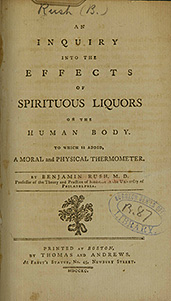-
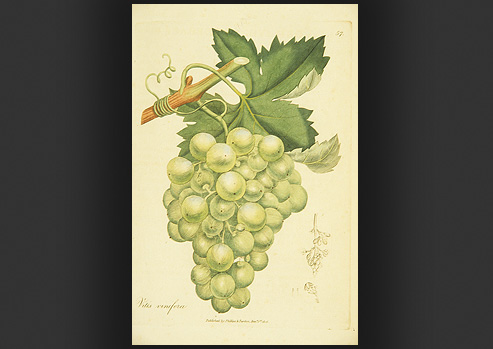
Vitus vinifera from William Woodville, Medical botany: containing systematic and general descriptions, 1832
Courtesy National Library of Medicine
 BOTANICAL, Vitus vinifera
BOTANICAL, Vitus vinifera57 Vitus Vinifera Published by Phillipe…
-
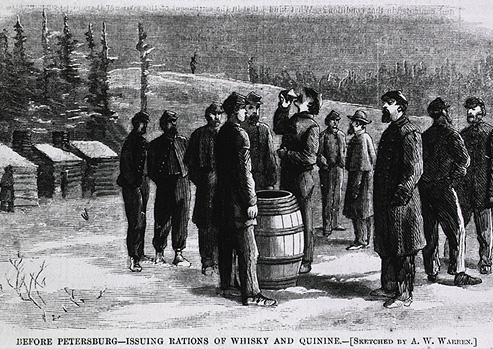
A. W. Warren, “Before Petersburg—Issuing Rations of Whisky and Quinine,” Harper’s Weekly, 1865
Courtesy National Library of Medicine
 CURATIVE, Whiskey Cure
CURATIVE, Whiskey CureDuring the 1800s, many physicians endorsed the medicinal properties of wine, beer, and liquor as a treatment for malaria, to improve overall feelings of well-being, and to retain youthful vigor, if taken in specific doses for certain disorders. During the Civil War, military leaders issued whisky and quinine to soldiers.
-
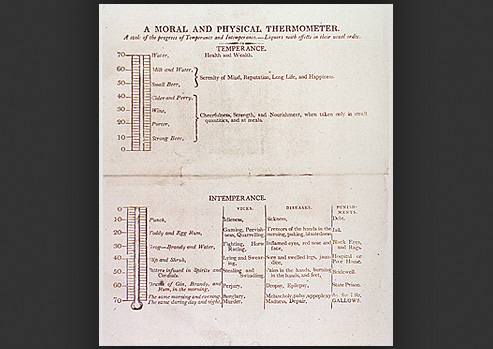
“A Moral and Physical Thermometer” in Benjamin Rush, An Inquiry into the Effects of Ardent Spirits upon the Human Body and Mind, 1784
Courtesy National Library of Medicine
 CURATIVE, Risky Remedy
CURATIVE, Risky RemedyDr. Benjamin Rush, a prominent physician and signer of the Declaration of Independence, was so concerned about the dangers of alcohol that he predicted great risk to the future of the new republic caused by drunken voters.
A MORAL AND PHYSICAL THERMOMETER
A scale of the progress of Temperance and Intemperance. – Liquors with effects in their usual order.
TEMPERANCE.
Health and Wealth.
70,60,50,40,30,20,10,0
Water, Milk and Water, Small Beer, Cider and Perry, Wine, Porter, Strong Beer, Serenity of Mind, Reputation, Long Life, and Happiness.
Cheerfulness, Strength, and Nourishment, when taken only small quantities, and at meals.
0,10,20,30,40,50,60,70
Punch, Toddy and Egg Run, Grog- Brandy and Water,
Flip and Shrub, Butters infused in Spirits and Cordials.
Drams of Gin, Brandy and Run, in the morning,
The same morning and evening, The same during the day and night
VICES.
Idleness, Gaming, Peevishness, Quarrelling, Fighting, Horse Racing, Lying and Swearing, Stealing and Swindling, Perjury, Burglary, Murder,
DISEASES.
Sickness, Tremors of the hands in the morning, puking, bloatedness, Inflamed eyes, red nose and face, Sore and swelled legs, jaundice, Pains in the hands, burning in the hands and feet, Dropsy, Epilepsy, Melancholy, palsy, apoplexy for Life, Madness, Despair,
PUNISHMENTS.
Debt. Jail. Black Eyes and Rags. Hospital or Poor House. Bridewell. State Prison. GALLOWS. -
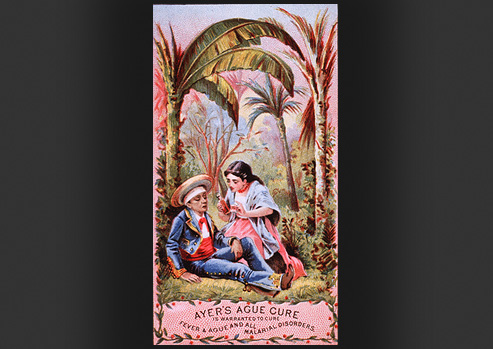
“Ayer's Ague Cure is Warranted to Cure Fever & Ague and All Malarial Disorders,” 1800s
Courtesy National Library of Medicine
 MARKET, Peddling Miracles
MARKET, Peddling MiraclesManufacturers of patent medicines, which were sold directly to the public without a physician’s prescription, realized the popularity of alcohol-based remedies. J. C. Ayer marketed a number of different tonics that included alcohol for a variety of ailments, including the Ayer’s Ague Cure for malaria.
Ayer’s Ague Cure is Warranted to Cure Fever & Ague and All Malarial Disorders
-
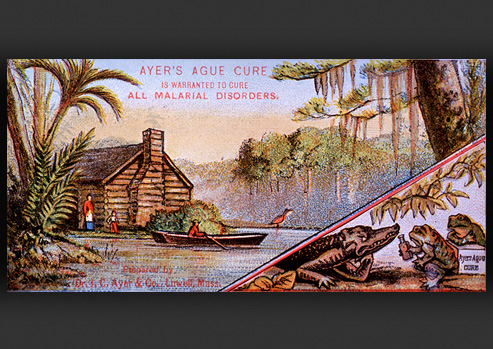
“Ayer's Ague Cure is Warranted to Cure Fever & Ague and All Malarial Disorders,” 1800s
Courtesy National Library of Medicine
 MARKET, Peddling Miracles
MARKET, Peddling MiraclesManufacturers of patent medicines, which were sold directly to the public without a physician’s prescription, realized the popularity of alcohol-based remedies. J. C. Ayer marketed a number of different tonics that included alcohol for a variety of ailments, including the Ayer’s Ague Cure for malaria.
Ayer’s Ague Cure is Warranted to Cure All Malarial Disorders
Prepared by Dr. J.C. Ayer & CO. Lowell Mass. -
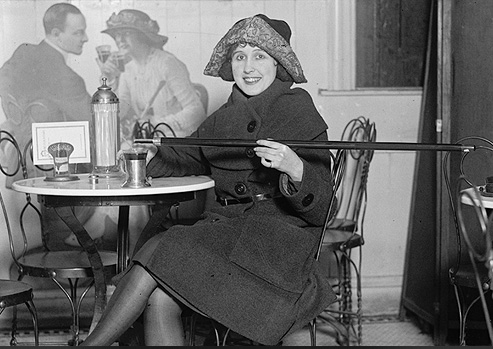
During Prohibition, a woman smuggles a personal serving of “giggle water” or alcohol in a hollow cane to add to her drink, 1922
Courtesy Library of Congress
 CONSUMER, Revelry
CONSUMER, RevelryMen and women, and all classes of people have imbibed to celebrate events such as the completion of a town hall or church, to greet the arrival of visitors, or to relieve stress. Some would go to extra lengths to enjoy their drink.
-
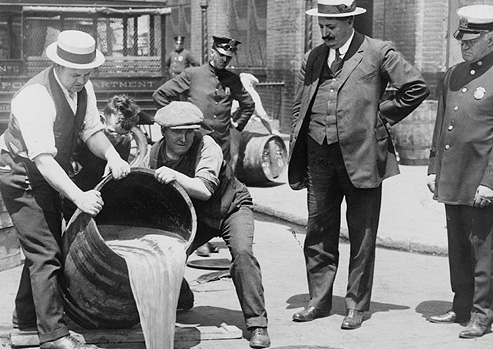
Agents pour liquor into a New York City sewer following a raid during Prohibition, ca. 1921
Courtesy Library of Congress
 PROHIBITIVE, Wet vs Dry
PROHIBITIVE, Wet vs DryThe temperance movement was fueled by moral concerns over the perils of alcohol consumption as well as anti-immigrant anxieties about drinking among Irish tavern-goers, German brewers, and others. After decades of debate, the government introduced national prohibition in 1919. The law proved impossible to enforce and was repealed in 1933.
In colonial America, home-brewed beer was popular among farmers and the working class and came to accompany a wide range of special events. Many physicians were enthusiastic about the medicinal properties of alcohol. As critics began to note the deleterious effects of frequent indulgence, reformers lobbied for tighter restrictions on the sale and purchase of alcoholic beverages. When prohibition outlawed alcohol manufacture and consumption, physicians retained the right to administer it by medical prescription.


